
MAY CONTAIN NUTS

Search Shorpy
SHORPY ART

Framed or unframed, desk size to sofa size, printed by us in Arizona and Alabama since 2007. Explore now.
Join and Share
Ad-Free Shorpy
Shorpy is funded by you. Patreon contributors get an ad-free experience.
Learn more.

Recent comments
- Freeze Frame
- Texas Flyer wanted
- Just a Year Too Soon
- WWII -- Replacing men with women at the railroad crossing.
- Yes, Icing
- You kids drive me nuts!
- NOT An Easy Job
- I wonder
- Just add window boxes
- Icing Platform?
- Indiana Harbor Belt abides
- Freezing haze
- Corrections (for those who care)
- C&NW at Nelson
- Fallen Flags
- A dangerous job made worse
- Water Stop
- Passenger trains have right of way over freights?
- Coal
- Never ceases to amaze me.
- Still chuggin' (in model form)
- Great shot
- Westerly Breeze
- For the men, a trapeze
- Tickled
- Sense of loneliness ...
- 2 cents
- Charm City
- What an Outrage
- Brighton Park
Member Photos
The Shorpy
Print Emporium
Print Emporium
Search Shorpy
Search results -- 30 results per page
- Cheerful Charlie: 1914
- New York, 1914. "Charlie White." Chicago lightweight born 1892 in Liverpool; retired from the ring in 1925. 5x7 ... from Welsh."
from Wikipedia
(The Gallery, Chicago, NYC, Sports) ... Posted by Dave - 07/18/2016 - 7:56pm -
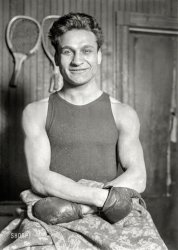
- Isolette: 1962
- Chicago circa 1962. "Miss Eileen Dawson of American City Bureau at Tri-State ... figured I wouldn't make it.
(Technology, The Gallery, Chicago, Medicine, News Photo Archive) ... Posted by Dave - 04/08/2017 - 6:42pm -
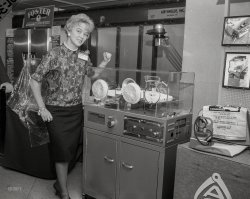
- Ask at Bar: 1941
- ... According to the book After Capone: The Life and World of Chicago Mob Boss Frank "the Enforcer" Nitti, Manhattan beer was mob owned, ... Posted by Dave - 01/09/2018 - 8:41pm -
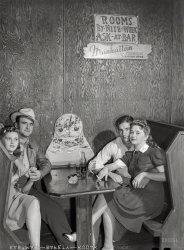
- Central Station: 1901
- ... 1901. "Illinois Central Depot, 12th Street and Park Row, Chicago." 8x10 inch dry plate glass negative, Detroit Photographic Company. ... of Music (in a night-time view, below).
(The Gallery, Chicago, DPC, Railroads) ... Posted by Dave - 04/24/2018 - 1:57pm -
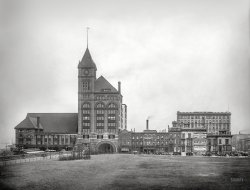
- Hygeia Hotel: 1895
- ... class) while the elusive ship on the right could be the Chicago.
At first I thought the one on the left was Olympia, but the ... Posted by Dave - 04/25/2016 - 11:00am -
![Hygeia Hotel: 1895 Hampton Roads, Virginia, circa 1895. "Boat landing at Old Point Comfort and Hygeia Hotel." 8x10 inch dry plate glass negative. View full size.
Razed by the FedsThis, the second Hygeia Hotel, was torn down in 1902 after the feds took the land back. Its neighbor, the Chamberlin Hotel, did however burn to the ground in 1920 and was replaced by the massive brick pile which still stands.
Hygienic HygeiaNote the spray of droplets emanating from the sprinkler bar on the tank watering the road.
Quite the HotelWant an inside look?
Also About Those ShipsI think Atlanta is indeed the most likely suspect. According to The Dictionary of American Naval Fighting Ships the Olympia was built in San Francisco at Union Iron Works, commissioning on 5 February, 1895. She left Mare Island on 25 August, 1895 to join the Asiatic Fleet. Boston was at Mare Island from 7 October, 1893 until 10 January, 1896 when she too departed for the Far East. That seems to leave Atlanta to be the ship as she spent her time in the North Atlantic Squadron.
"New Navy" ShipsLike today, Hampton Roads was a major naval base in 1895. Some of the ships in the background are recognizably some of the steel vessels built to modernize the Navy at the end of the 1880's.
The brig-rigged vessel at the left is almost certainly of the Atlanta class. The schooner-rigged 2-stacker in the middle is the San Francisco. These can be identified from drawings on Pages 18 and 27 of Friedman's "US Cruisers: an Illustrated Design History."
The Atlanta class of 3 ships was commissioned from 1886 to 1889, while San Francisco was commissioned in 1890.
The vessel on the right seems not to match anything in the book; she appears to be barkentine rigged. I'm open to suggestions.
All these Navy ships have the period appropriate paints scheme of white topsides and buff superstructures -- of course we can't tell that from this black and white image.
Flag detailForty eight stars showing on the high flying flag. Still years out in 1895.
[You're counting wrong. - Dave]
Oops! I tried short cut: six down times eight across top. Me bad.
[Eight across the top, eight across the bottom, and four rows of seven. - Dave]
USS OlympiaI do believe that that would by the USS Olympia in the background given the twin masts and double smokestacks and the year, as the USS Boston, USS Kearsarge were not part of the fleet until 1898.
The Question Every Shorpyite is AskingWhen did it burn down?
One year 'til UtahDave is right about the number of stars---two rows of eight and four rows of seven---44. Utah became Number 45 in 1896.
About those shipsIn my most humble opinion, I believe the ship on the left is either Atlanta or Boston (same class), the one in the middle either the Philadelphia or San Francisco (same class) while the elusive ship on the right could be the Chicago.
At first I thought the one on the left was Olympia, but the funnels are not quite right, nor the masts. It is maddening, there is just enough visible to make you sure you don´t know for sure.
Further About Those ShipsThe ship on the right could be the gunboat USS Petrel. The funnel and rigging seem to match. If that's the case, it would put the picture a bit earlier, as she was reassigned to the Asiatic Squadron (Hong Kong) in 1891.
(The Gallery, Boats & Bridges, DPC, Horses)](https://www.shorpy.com/files/images/SHORPY-4a15010a.thumbnail.jpg)
- Clinton Square: 1905
- ... styles in rapid succession; in 1886 he moved his office to Chicago where he designed many Shingle Style houses and became the first ... Posted by Dave - 07/30/2012 - 4:36pm -
![Clinton Square: 1905 Syracuse, New York, circa 1905. "Clinton Square." 8x10 inch dry plate glass negative, Detroit Publishing Company. View full size.
Syracuse Savings BankThe big Victorian Gothic structure at the right is Joseph Lyman Silsbee's Syracuse Savings Bank Building of 1875-1876. Silsbee became proficient in several architectural styles in rapid succession; in 1886 he moved his office to Chicago where he designed many Shingle Style houses and became the first employer of a young man from Wisconsin named Frank Lloyd Wright.
By the names on the shopsWe can see where the Irish migrated to. Also great to see products moved by boat, what canal is that??
[The Erie Canal. -Dave]
Detailed Picture!The headboard and chairs appear to me to be carefully wrapped, perhaps in cotton batting and twine.
The young roustabout near the grocery wagon is looking at the toppled grain sack as if it's a wonder of nature. I wonder if he got motivated enough to clean it up or pulled a "Bart Simpson"?
The gent in the nice threads probably should make that much. He might be the barge captain, owner or both.
Just in front of D. Moran's grocery wagon across the street is that a boy pushing a woman in a wheelchair?
The lawn and flower beds are nicely tended. The garder (street cleaner?) and the young girls all have their attention drawn across the street. Was that horse startled?
Some serious window cleaning on the second floor above O'Herin's. There is a woman in the first floor window. Taking a break or a "desperate houswife" of 1905?
Mailbox, policeman and young boy with a basket on the corner. I wonder what the boy is doing? I know the policeman is on his way from the cigar store to the doughnut shop.
Great bridge design.
Interesting wagon-mounted two man lift.
Great picture but it takes an hour to view!
OverseerThere's a guy with a pipe watching the three guys roll the barrel up the ramp into the boat. I assume he earns as much per hour as all three laborers put together.
AbridgedNow there's something you don't see every day, or ANY day for that matter, a pedestrian lift bridge that is usable in both the lowered and raised positions! Clever!
Hubbard's Empty CupboardThe empty wagon proclaiming "Chas Hubbard Son & Co, esale, STS" belonged to Charles Hubbard, Wholesale Druggists, 211-213 North Water Street, Syracuse, NY. That address no longer exists, being now part of the James Hanley Federal Building in downtown Syracuse. Mr. Hubbard's rise to pharmaceutical prominence can be read about here.
(The Gallery, DPC, Stores & Markets, Syracuse)](https://www.shorpy.com/files/images/SHORPY_4a12803a.thumbnail.jpg)
- Texaco Tanker: 1925
- ... When I was a kid during the 40s on the west side of Chicago, that same type of Mack truck delivered coal to our apartment building. ... Posted by Dave - 09/03/2012 - 10:44am -
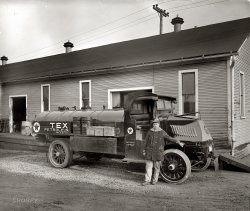
- The Wounded: 1864
- ... apparently, most old brick buildings here in Chicago are the same way, including my 2-flat which was built in 1914. I never ... Posted by Dave - 05/19/2008 - 8:52pm -
![The Wounded: 1864 May 1864. "Kearny's men wounded at Fredericksburg." Wet plate glass negative, right half of stereo pair. Photograph by James Gardner. View full size.
Wounded.Priceless. So much to derive from examining this photograph.
I love Shorpy.
Philip KearnyPhil Kearny was killed in action 18 months before this picture was taken. I guess his division kept his name.
Also, all these Fredericksburg photos show the brickwork to be done in Scottish Bond: one row of headers, then 5 rows of stretchers, repeat. It must have been popular with the local masons.
And we need a real Civil War expert to explain the cross on the 2nd man from the left. All the Kearny Crosses I've ever seen were metal, but this soldier seems to be wearing a cloth cross.
[His Wikipedia entry says cloth crosses. - Dave]
Kearny is credited with devising the first unit insignia patches used in the U.S. Army. In the summer of 1862, he issued an order that his officers should wear a patch of red cloth on the front of their caps to identify themselves as members of his unit. The enlisted men, with whom Kearny was quite popular, quickly followed suit of their own volition. Members of other units picked up on the idea, devising their own insignia, and these evolved over the years into the modern shoulder patch.
Sergeant Major's CrossThe cross badge worn by the Sergeant Major (second man from left) was likely an insignia denoting that he was a member of the 6th Corps, Army of the Potomac. Original badges were generally worn on the top of the kepi, left side of the hat, or over the left breast. Issued enlisted men's badges were cut from colored material.
Scottish BondNot just popular in Fredericksburg apparently, most old brick buildings here in Chicago are the same way, including my 2-flat which was built in 1914. I never knew the name for this style before, thanks!
(The Gallery, Civil War, James Gardner)](https://www.shorpy.com/files/images/03385u_0.thumbnail.jpg)
- Dancing in the Dark: 1940
- ... these commercials with trippy cartoon bears from Chicago TV in the late 70s. The B&W commercials from the 50s are very ... Posted by Dave - 12/19/2019 - 10:59am -
![Dancing in the Dark: 1940 November 1940. "Pierre, South Dakota, on a cold night." Home of the Dome, luring passersby with "Beer and Dancing." Acetate negative by John Vachon. View full size.
Hamm's, the beer refreshingI remember these commercials with trippy cartoon bears from Chicago TV in the late 70s. The B&W commercials from the 50s are very similar, as it turns out.
Beer -- AND dancing, I'm going in here!!
Question for ShorypitesCan someone tell me if there is a practical purpose for those buttresses at the bottom of the doorway to the store next to The Dome, or are they just cosmetic?
[Pedestrian collision prevention. - Dave]
Thanks.
BrrrrrrrrrrrYou can feel the icy wind that carved it's its presence in the snow at the curb.
At least I act like I knowAnd booths! We all know what goes on in those!
Beer indeedPierre rhymes with beer. All puns intended.
A frigid night in Pierre. Not much going on.Hey, it's 20 below zero. Why not stumble into the Dome and have ... a cold beer!
Hamm's, the beer "from the land of sky blue waters". I remember the commercials as a kid, with the bear and the intentionally Native American beat with the tom-toms.
Look upThe fancy Corinthian columns at The Dome's entrance are a nifty touch, although a trifle out of balance with the sturdy dentil molding adorning both that building and the one beside it. Perhaps it was to distract from the fact that your nose just froze and fell off your face.
I'd like to danceWith someone warm.
Uh Am BrrrThat's how your order sounds when your lips are frozen ... A Hamm's Beer is how your order sounds when you can feel your lips again. I know this.
(The Gallery, Eateries & Bars, John Vachon, Small Towns)](https://www.shorpy.com/files/images/SHORPY-8c18093a.thumbnail.jpg)
- The Junkman Cometh: 1942
- October 1942. Chicago, Illinois. "Salvage. To feed the nation's munitions furnaces, tons of ... IS OVER! THE WAR IS OVER!"
(The Gallery, Ann Rosener, Chicago, WW2) ... Posted by Dave - 06/10/2018 - 11:01pm -
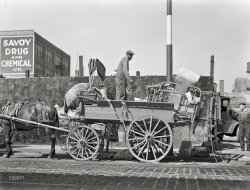
- Detroit Rubber Works: 1908
- ... century that moving from bicycle tires to auto tires, and Chicago to the Detroit, was the way to go. Thus, around the time of this photo, Morgan & Wright Bicycle Tire Co. of Chicago became Morgan and Wright Rubber Works on East Jefferson Avenue and ... Posted by Dave - 09/04/2021 - 10:41am -
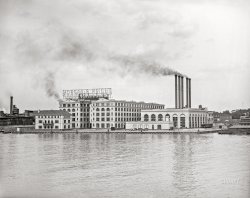
- New York World: 1905
- ... Row) to the top of the flagpole. The Masonic Temple in Chicago -- seen here last year on Shorpy -- had a much better claim at 302 ... Posted by Dave - 08/01/2012 - 5:47pm -
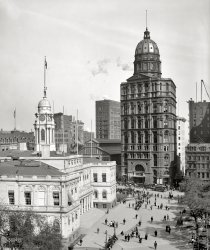
- Condemned: 1939
- ... used to work with a woman who grew up on the South Side of Chicago in a neighborhood that was later razed for the notorious (to say the ... buildings falling over, unpaved streets in the middle of Chicago in the middle of the 20th century. Charles Cushman's incredible photos ... Posted by Dave - 08/30/2012 - 11:04am -
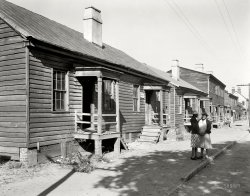
- Bank Garage: 1934
- ... In later years the Gold Rush-era building here housing the Chicago Specialty Co. became the law offices of flamboyant San Francisco ... Posted by tterrace - 05/16/2015 - 8:27am -
![Bank Garage: 1934 San Francisco April 14, 1934. "East side looking south, Montgomery Street commercial buildings." In later years the Gold Rush-era building here housing the Chicago Specialty Co. became the law offices of flamboyant San Francisco attorney Melvin Belli. Today this block is part of the Jackson Square Historic District, while down the street at the next corner the Transamerica Pyramid rises. Large format negative by Roger Sturtevant for the Historic American Buildings Survey. View full size.
Magnificent FailureBarely visible, at the right, is a 34 DeSoto Airflow.
Is that Geppetto's Workshop?Since there is a decidedly Italian flavor to this neighborhood, I noticed that just between the Conradi Mountain Wines and Washington Broom Co., at 728 Montgomery, there is a tiny doorway advertising "Puppets". My imagination wanders to thoughts of a hand-carved Pinnochio or other individually made specialties. Could there have actually been a business that sold only puppets?
[That was Perry Dilley's Puppet Theater. -tterrace]
The Montgomery BlockThe four story building in the next block (now the site of the Transamerica pyramid) was the historic 1853 Montgomery Block.
First a professional office building and at one time the tallest structure west of the Mississippi, then later known for artists, writers, and various bohemian inhabitants, it was demolished to make way for a parking lot in 1959.
Whats that?What is the flag on the tower in the distant background? looks like an eagle?
[It's atop the Shell Building at Bush and Battery. -tterrace]
That flag in the distance Could it possibly be a NRA (National Recovery Act) flag?
[Here's an example. -tterrace]
Facelift in progressA few updates here and there, but generally well preserved:
Dorothea LangeThe 728 Montgomery St. photo studio of Dorothea Lange was up the stairs to the left of the sign for Conradi Ltd Mountain Wines.
[Her husband, artist Maynard Dixon, had his studio at 728. Lange's had been at 716 and later 802 Montgomery. -tterrace]
Oldest signPage 213 of "San Francisco of the 1930s," published by the WPA says, "San Francisco's oldest sign, hanging from the Genella Buiulding, 728 Montgomery St., states in faded black and gold letters that 'H. and W. Pierce...Loans and Commissions' once did business here, exchanging paper and coins for gold bullion."
Melvin BelliI used to wander SF in the late '60s, photographing things that interested me. On a couple of occasions I walked past Mel Belli's offices and glanced in the windows, and did see him inside once or twice. I have lived near Sonora California for 20 years now, which is where Mr. Belli was born and raised, and is now buried.
For many, many years, Mel Belli listed his personal phone number in the SF phone directory (anyone remember those, LOL). However, instead of putting it in his own name, he listed it in his dogs' names - Weldon Rumproast. Over the years he had several dogs with that name, adding a number at the end. A friend once found the name Weldon Rumproast III in the phone book and called it. He spoke with Melvin Belli for quite some time, and it wasn't until they nearly finished the conversation that he realized who it was he was speaking to!
(HABS, San Francisco)](https://www.shorpy.com/files/images/016074pu.thumbnail.jpg)
- Cow Boy: 1939
- ... in 1893, originally as the Universal Fastener Company, in Chicago. They later moved to Hoboken, New Jersey, and finally to Meadville, ... Posted by Dave - 12/20/2017 - 10:02am -
![Cow Boy: 1939 September 1939. "Son of dairy farmer. Dakota County, Minnesota." Photo by Arthur Rothstein for the Farm Security Administration. View full size.
Separating the sheep from the goatsIt takes a photo like this bit of agricultural magnificence to separate the hack photogs from the truly greats. Thank you, Arthur Rothstein. No one could've done this better.
Mud in his eyeI see a man in a hat with a bulky coat reflected in the boy's eye. Pareidolia or Rothstein?
Cowden Bit the DustThe Cowden Manufacturing Company, of Lexington, KY, manufacturer of men's and boy's clothing, was bought by Interco in 1964. Eventually, Interco wound down its clothing operations, and Cowden was no more. See more here.
Grass toothpicksI frequently had a Timothy stem in my mouth as a kid, this boy has something different though. I learned it by imitation from grandpa and liked the brief, sweet taste. He told me about a few other types that offered a different taste, often bitter but I've forgotten most of them. Sometimes I used it used the stems as a toothpick for the goofy gap in my front teeth.
The eyesWow. Definitely one of the best photos I've seen on this site. And there are a lot of "best" photos.
The overalls seem to be the same brand as the one here: https://www.shorpy.com/node/2462. Photo is also by Arthur Rothstein.
Whatever happened to Cowden? Couldn't find much other than they might have gone out of business around 1948.
[Scroll down! - Dave]
Yup, was actually submitting this one for posting before the answer was up.
Re chewing on grass (bwayne), don't know what it was but as a kid, some of us did that. I didn't like the taste of it, so I was not one of them constantly doing it. More recent years, kids I know would do. Haven't got a clue, though, as to what kind of fodder it was. Don't think it is anything that will ever stop.
Chewing on GrassI'm not sure where the practice of sticking some sort of grass or straw stem in the mouth and chewing on it came from but obviously Manhattanite Rothstein thinks it enhances the rural feel. We had farms for 40+ years and yes, I tried it once or twice very early on. Foxtail tastes bitter and I never saw anyone do it but a citified greenhorn visiting the farm.
Farm LifeMy mom was a child of a farmer in Wisconsin during the Depression. She says even though they didn't have much money they never went hungry, unlike my city kid dad, who knew what it was like to go without meals.
Pastures aplentyBefore suburban sprawl made Dakota County Minnesota’s third-most populous county, dairy reigned. As Alistair Cooke of the BBC wrote when touring America three years after Rothstein’s photo was taken, “for thirty miles north of Faribault, you swing over wonderful dairy pastures where every prospect pleases and the land seems abundantly able to answer any call the Army or the government could make on it. Intermittent stands of maples and oaks are just so much pleasing decoration to sweeping acres that fatten sleep Holsteins for the butter and cream market. . . . You follow the Cannon River for a while, and at Farmington they are so indisposed to launch into sales talks that you have to wring from a member of the Milk Producer’s Cooperative the astounding fact that this small town of about 1,500 souls receives every day a quarter-million pounds of milk.” (Cooke, “The American Home Front: 1941-1942” at p. 254.)
Look close, a Talon zipperTalon Zipper is a company founded in 1893, originally as the Universal Fastener Company, in Chicago. They later moved to Hoboken, New Jersey, and finally to Meadville, Pennsylvania. It was in Meadville that the zipper as we know it was invented, until then they were producing hookless fasteners for boots and shoes. Here, the zipper was mass-produced beginning in the 1920s.
Chewing on ... whateverOur grandson loves chewing on Oxalis stems.
Very sour, but somehow attractive...
On chewing grassIt's worth noting that when you pull a blade of grass, the white part at the base is slightly sweet, and when you enjoy that, even the more bitter part is actually kind of tasty. Boy Scouts are taught this as a survival tactic.
SunfloweredI used https://deepdreamgenerator.com/
To generate an image combined with sunflowers. Looks appropriate to me.
[I'm pretty sure those are daisies! - Dave]
(The Gallery, Agriculture, Arthur Rothstein, Kids)](https://www.shorpy.com/files/images/SHORPY-8b37893a.thumbnail.jpg)
- Action Comics: 1940
- ... popcorn machine at the World's Columbian Exposition in Chicago in 1893. Scientific American reported: "This machine ... was designed ... Posted by Dave - 06/18/2018 - 1:20am -
![Action Comics: 1940 April 1940. "Popcorn stand in Globe [i.e., Miami], Arizona." Where we can pick up a slightly dog-eared copy of Famous Funnies or Action Comics #23 for a dime. Decisions, decisions! Medium format negative by Russell Lee. View full size.
N°2 WagonFrom the 1925 Cretors catalogue:
A GREAT favorite, and the cheapest wagon machine we build. Thoroughly dependable in operation; very simple and durable. Hundreds of these machines are being used in connection with stores, sidewalk stands and other lines of business, with gratifying results.
A No. 2 Wagon operated in front of your store is worth its cost as an advertisement alone. We are pleased to continue a model which in the past has proven itself the most successful and best money getter of any machine on the market of equal price.
Store owners cannot afford to ignore this attractive and profitable adjunct to their business.
Peanut Roaster capacity, about 10 pounds.
Dimensions — Frame, 20 inches wide by 52 inches long. Popper case, 20x20x24 inches high. Extreme width, 31 inches. Height, 5 feet 10 inches. Weight, about 300 pounds.
Write for Special Bulletin and complete Specifications.
Price and Installment Terms on Request.
Get your popcorn readyC. Cretors & Co. has been around for a good long time.
Charles Cretors introduced the world's first mobile popcorn machine at the World's Columbian Exposition in Chicago in 1893. Scientific American reported: "This machine ... was designed with the idea of moving it about to any location where the operator would be likely to do a good business. The apparatus, which is light and strong, and weighing but 400 or 500 pounds, can be drawn readily by a boy or by a small pony to any picnic ground, fair, political rally, etc. and to many other places where a good business could be done for a day or two."
https://www.popcorn.org/Facts-Fun/History-of-Popcorn/History-of-Popcorn-...
Fior D'Italia boarding houseOne recurring facet of life in mining towns like Globe was the presence of boarding houses with sarcastically classy names. Beyond the popcorn machine may be seen the Fior D'Italia boarding house. That was also the name of a business establishment in San Francisco that now claims to be the oldest restaurant in the city. Little sign can be found of the fate of this humble abode, which is not among the places mentioned in the Globe Downtown Historic District registry.
[Pretentious, maybe, but sarcastic? According to the sign, the proprietor is one Angelina Bairo (1880-1955), born in Turin, which would explain the name, which means "Flower of Italy." - Dave]
Action Comics 23This issue was the first appearance of Lex Luthor.
This very issue is on eBay for $6,500.
Got a dime?That dime would have bought you a comic now worth somewhere between $1000 (min) and $65,000 (record). #23 was the first appearance of Lex Luthor.
Busty lady of shady laneForget the comic books. The boys might be more distracted by the sexy lady on the cover of "True Confessions," which was kinda brazen for 1940.
Even after using PhotoshopI can't make out what that sign in the window says. Help, anyone?
[Magazines 5¢ - Dave]
Thanks!
$14,694Check out this copy of Action #23 -- winning bid $14,694.
It's a mini-steam plant!It's got it all!
1) Cute mini single-cylinder steam engine with a round belt going off to the lower right. (Belt visible behind the "4 o'clock" position of the flywheel.)
2) Feedwater tank on the left side.
3) Boiler water level glass on the right end.
4) Firebox drawer front and center, right below the smokestack which goes up the left side of the glass popcorn chamber
5) Last but not least, a steam pressure gauge which seems to be calibrated 0-60 PSI. One could presume a working pressure in the middle of that range.
In today's world, one would need a boiler operator's license to run a boiler with a working pressure of 30 PSI. The boiler would have to have an inspection certificate.
Certainly an interesting machine!
Re: True ConfessionsMy eyes are up here, Mister!
413 Sullivan Street.I believe, based on the windows and openings in the building, and the hill in the background, that we are here:
(The Gallery, Russell Lee, Stores & Markets)](https://www.shorpy.com/files/images/SHORPY-8b24474a.thumbnail.jpg)
- Immense Chewing Candy: 1904
- ...
Mexican Penochis This from Historical Sketch of the Chicago Confectionery Trade:
BELL, Jonas N.
Started jobbing and is now ... Pecan Nuts, Tin Boxes 30 cents, 604 W. Madison
Street -- Chicago"
Page 83, 119, 122 (Ad/Photo)
Low down on Mexican penochis... ... Posted by Dave - 12/07/2013 - 9:42pm -
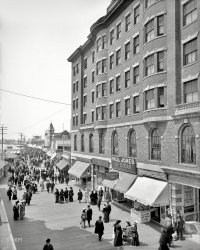
- Aerial Omaha: 1938
- ... of its completion in 1912 the tallest building between Chicago and the West Coast. - Dave]
No Apartments Available The three ... Posted by Dave - 09/14/2017 - 9:05pm -
![Aerial Omaha: 1938 UPDATE: Our vantage point for this view north along 14th Street is the Woodmen of the World tower at 1323 Farnam.
November 1938. "Omaha, Nebraska." Gateway to the West. Medium format negative by John Vachon for the Farm Security Administration. View full size.
FansAnyone aware of what the contraption is on top of the building on the left. I see fan units. Was this an air conditioning system? If so it is very narrow.
Three Corner TavernsInteresting to note the small corner taverns in the Omaha photographs: in the “Omaha Suds” image, in the Theodore's Place image, and the Oaks Tavern in this image. Three corner taverns, each about the same size and height, although some more decorated than the other. I wonder how many others existed?
Across the street is the Paris Bar and Billiards. Oaks and Paris advertised together.
What Depression?For a small city during the worst of the later Depression years, this photo portrays an impressive proportion of late model vehicles. As opposed to the trucks, the great majority of the cars seen here are within 3 or 4 years of age if not newer -- a mix probably not excelled in most U.S. localities today.
Brand new Ford TudorThe car almost directly in front of the "Nebraska" is a new 1938 Standard Ford V8. I've had one of these since the late 1970's. Once considered the ugly duckling of the 30's by almost everyone is now kinda good looking. Kinda.
Scorch marksSo what was the commercial establishment that burned at the corner of 14th and Capitol? Whatever it might have been, the fire appears to have thoroughly gutted the place.
Pay no attentionI'm assuming that this picture was taken from an airplane, so it's interesting that none of the many people on the street are looking up at the photographer. It seems like an airplane flying low over the downtown area would attract a lot of attention!
[The photo was taken from the Woodmen of the World building at 1323 Farnam Street. - Dave]
Gateway to the WestJust a minute, that nickname belongs to my native city, Winnipeg, Manitoba. But wait, Wikipedia points out that it also refers to no fewer than 6 cities in the US (Fargo, Fort Wayne, Omaha, St. Louis and the Gateway Arch, Kansas City, Pittsburgh) and one whole state (Oklahoma, although particularly Tulsa).
Location, Location, Location?I believe this photo was taken from a building on the southeast corner of 14th and Farnam. In an aerial photo from the early 1950s I can see a tall building located at that corner.
Furthermore, in that aerial photo I can clearly see the Hotel Fontenelle a few blocks to the west at 1806 Douglas and I can positively identify the fronts of the buildings in the 1300 block of Douglas where Palace Billiards and the Oaks Bar were.
[You are correct about the location (my first guess, the Hotel Fontenelle, is on the wrong block). Which means our vantage point is the 19-story Woodmen of the World headquarters, at the time of its completion in 1912 the tallest building between Chicago and the West Coast. - Dave]
No Apartments AvailableThe three story brick building being demolished was an apartment building offered for sale in January 1937. Directly across the street from it was the “Hummel Auto Shed” and the Omaha World Herald delivery truck garage and parking lot and the vacant space diagonally across the street was the site of the Jefferson Hotel, demolished in 1935.
Win some, lose someBetween the Oaks Bar and the Nebraska theater is a campaign office with banners for 19938 candidacies of (James T.) English for (Douglas) County Attorney, and (Frank) McGrath for (Douglas County) Clerk of Court. English won, and later became a state-court judge. McGrath, an incumbent mired in scandals, lost.
(The Gallery, John Vachon, Omaha, Railroads)](https://www.shorpy.com/files/images/SHORPY-8b14207a.thumbnail.jpg)
- Amarillo: 1943
- ... by Jack Delano on his trip via the Santa Fe rails from Chicago to California in March 1943. 4x5 Kodachrome transparency, Office of War ... Posted by Dave - 08/05/2012 - 6:35pm -
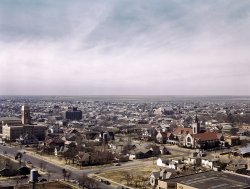
- The Pool Board: 1943
- ... operations on the Indiana Harbor Belt railroad between Chicago and Hammond, Indiana. The engine crew, engineer and fireman report at ... Posted by Dave - 09/29/2013 - 11:41am -
![The Pool Board: 1943 January 1943. "Freight operations on the Indiana Harbor Belt railroad between Chicago and Hammond, Indiana. The engine crew, engineer and fireman report at the roundhouse office to be assigned their engine and given orders for the day. The cylinder at the left is the pool board; it lists the names of the men and the order and shift in which they will work." Photo by Jack Delano. View full size.
Wooden box with crankAnyone know what the wooden box with a crank handle is on the side of the desk over the trashcan? Being over the trash suggests some sort of shredder, but it's hard to imagine what they would have that needs shredding.
A little cranky?@Carey - that is a telephone ringer. Inside the box is a magneto which generates a voltage so the operator knows there is an outgoing call. I used to have one just like this, which had bells on it like the one on the desk laying horizontally. They put out a good kick if you wanted to play a joke on someone.
One long waitThe crank is almost certainly a ringer for the phone system.The wooden box is in character for the elderly, in-house phone set ups. In the early 70's, B&O trackside phones in places had a crank on a wooden box with a mouthpiece from a Laurel and Hardy flick. Penciled inside the cabinet were the different rings, for example "HB Tower:2 short; A Yard:1 long,3 short; HX Tower:1 long, to which a wiseguy added, "...and one long wait!"
To use the phone, first you'd pick it up and make sure it isn't in use, then ring the call for your party,the other end would answer with a short ring and then you talk by pressing a button. [this was to prevent background chatter; it was one big party line...] All of this was made antique collectibles by the radio, even to the removal of the phone lines themselves.
With the callboard nearby, someone in this office is a crewcaller, so the in-house phone line is for talking to the dispatcher, the trainmaster, the engine facility, etc. There also is a phone line to the outside, and if a crewman was within a certain distance from this office, callboys would go out and call at their doors. My name was on a similar board back in the "analog era". I wish I'd saved my peg.
State-of-the-Art CommunicationsThat box with the crank is a magneto generator that produces ringing current of about 108 v.a.c.
It's matched up with the three oak ringers (one on the desk, two on the wall above the window), and the oak 3-hole jack box behind the archboard on the desk. These also work with the three selector boxes between the ringers on the wall.
Apparently he has 3 phone circuits. He chooses the one he wants to use with the jack box. To make an outgoing call, he cranks the magneto. Incoming calls are announced by the ringers, and the selectors control when the ringers announce an incoming call for this office.
Information about railroad telephone equipment of this era, including links to archived user's manuals, can be found here.
If you see oneyou’ve seen 'em all. There must have been a written code somewhere that all railroads subscribed to regarding yard office ambience. They were all the same until recently. Wires and bells and speakers everywhere. Wooden floors, bare bulbs, block phones, doors that closed somewhat tightly, and restroom facilities that challenged the dignity of anyone other than a rail. (The old Humboldt Yard Office of the Milwaukee Road had a urinal that consisted of a large sheet of tin fixed to the wall that one [there were no women in those days] would pee against, and the urine would run down the tin into a horizontal length of rain gutter.) Although I can’t be certain, I’m going to guess the featured picture was taken at the IHB Blue Island yard. The two guys in the window are in their locker room, apparently waiting for a clearance and orders, or getting ready to tie up.
Carbide lampThe bright image in the lower window appears to be a carbide lamp probably an oxweld they were extremely common for that time.
Pool boardHow does the pool board work? Is it meant to be rotated when there's a shift change, so that the current shift is visible and the off-duty shift is on the "dark side"?
What information is being represented? Why are the tags in pairs - is it driver/conductor teams? Does the column of tags with labels represent assignments to trains? Is the Pool In/Pool Out like the bench?
Merch, baby!The Shorpy Store (TM) doesn't seem to stock that attractive Shorpy(R) brand wastebasket... that's a missed revenue opportunity!
The tags.As this photo was taken in a roundhouse/engine terminal office, they'd be paired for an locomotive engineer and fireman. IHB in those days was a terminal/switching road, so the assignments would most likely be for switching jobs or transfer runs.
Pool Board quick [?]On B&O at least, the engineers' pool and conductors' pools were separate. Since one pool had a few more crews than the other, this was necessary.
Engineers pools included a fireman, and later, a trainee, while the conductors turns showed the head brakeman,flagman, and in 1943, maybe a swingman. If a position was vacant, no peg was there. Bulletins were issued weekly advertising vacancies on regular jobs/pool crew and new jobs.
If you look to the right side of that board, those tags seem to show regular train or probably yard assignments; these would show the engineer, fireman, conductor [yard foreman on B&O] and the switchmen.
In practice, if a man was off, i.e. sick or vacation, etc., his tag was removed from his regular assignment and shown in what ever status. Somewhere on that board are extra boards for engineers, road conductors, brakemen, etc. As these extra men are called, their pegs are placed on the appropriate job with its regular men; when their trip is over, they are marked back up on the extra list at the bottom.
Note there is a window behind the board; this way a man can look at the board to see where he "stands" as he marks up, and see where everyone else is too. (The crews were kept on the other side of the window. Time slips, orders, etc. were handed through the "dutch window" above the caller's head.An experienced man could look this board over and tell you what job he's working tomorrow, and what job you're working too.[Sorry, Dave. This is about as quick as I could make this...]
(Technology, The Gallery, Jack Delano, Railroads)](https://www.shorpy.com/files/images/SHORPY_8d24378a.thumbnail.jpg)
- Flo and Chuck: 1918
- ... or factory, or perhaps underground like the tunnels in Chicago.
Goldilocks I think the little hippy is way too young to drive ... Posted by Dave - 08/19/2012 - 4:36pm -
![Flo and Chuck: 1918 New York. March 16, 1918. "Florence A. Young and Chas. P. Rigo." 5x7 glass negative, George Grantham Bain Collection. View full size.
Zamboni?Anyone have any idea what the heck they are riding on? Maybe a old school zamboni?
Curls & CarsUntil the 20s, young boys frequently wore their hair this long, until it was time for first grade. I'm trying to figure out what they are sitting on, at first glance it might be a (by 1918) antique car, but the interior background and the assortment of levers makes me think this was some kind of internal trolley in a large store or factory, or perhaps underground like the tunnels in Chicago.
GoldilocksI think the little hippy is way too young to drive and Flo sure has some funky leg warmers.
PutteesFlo is wearing puttees for some reason, so she probably is also wearing trousers of some sort beneath her dress. Puttees are leg wrappings made of long strips of cloth, adopted by several armies during the WWI. The Brits were hugely big on puttees, while the US went for leggings, though puttees were also known in the US Army. Bob and Ray were known to work puttees into their radio routines.
She presents a very sturdy appearance...a woman in charge of something: Chas P. Rigo?
Flo-MowAnother shot of Florence on that riding mower. This was at the Sixth International Flower Show at Grand Central Palace on Lexington Avenue.
Hey Tut!(He's my brother.) There are pictures of our dad with very similar girly hair when he was just a little squirt. Our mom frequently makes fun of his mom for having his hair that long.
1920 CensusThese may be our folks from the 1920 Federal Census:
Trenton, NJ, Young, Florence A., head of household, female, white, 42, single, born New Jersey, occupation: custodian at State barracks.
Nutley, NJ, Rigo, Charles P., born 1915 in New Jersey, son of Paul H. and Ethel W. Rigo, white, male (only child); Paul H. is a florist with his own shop; the grandparents of Charles were from Germany.
No matches from the New York census. This photo must be of a brief encounter. Flo cuts the grass and Charlie's dad sells flowers.
Lady Gardener?The more I look at the photo of Flo and her outfit, the more I think she must have been "Florence A. Young, The Lady Gardener". Her costume certainly gives the impression of a person doing outdoor work -- you don't need puttees while dusting the crockery. Was she the Charlie Dimmock of her time?
[The leggings are because it's freezing cold outside. At 8 a.m. that day in New York it was 23 degrees, up from a low of 14. - Dave]
That's my Pop-PopCharles P. Rigo was my grandfather. His father was president of the New York Floral Society so his presence at this show makes sense. I do not know who Flo is, but I am sure going to try to find out.
(The Gallery, G.G. Bain, Kids, NYC)](https://www.shorpy.com/files/images/26356u1.thumbnail.jpg)
- Last of the Red-Hot Godmothers: 1960
- ... I'll never forget my confirmation party. Mid-party the Chicago cops knocked on the door saying my brother had stolen a car....long ... Posted by tterrace - 06/24/2009 - 4:51pm -
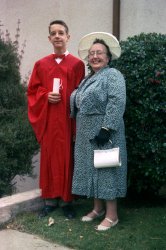
- White Castle: 1910
- ...
Sharpe's Chop House Here's another view.
Chicago is visiting Detroit and St. Louis is at Cleveland in both shots, but ... Posted by Dave - 10/17/2013 - 11:44am -
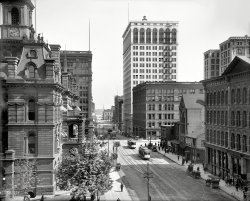
- Bicycle Crossing: 1943
- January 1943. "Freight train operations on the Chicago and North Western Railroad between Chicago and Clinton, Iowa. The train rushing through the town of Cortland ... Posted by Dave - 12/11/2014 - 12:07pm -
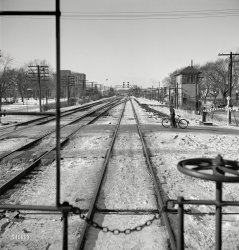
- Easy Payments: 1906
- ... from another store.
A photo from the Roseland (Chicago) store remnants:
And a closeup of that same logo on the ... Posted by Dave - 08/13/2012 - 9:14pm -
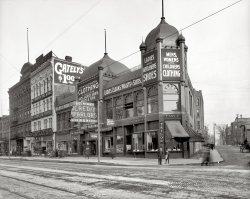
- Needles: 1943
- ... Passenger cars Santa Fe introduced the El Capitan train Chicago to Los Angeles long before double stack intermodals. The El Capitan ... Posted by Dave - 01/23/2013 - 5:33pm -
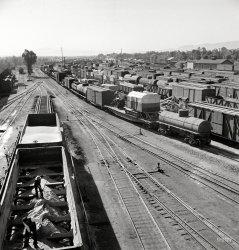
- Coney 1905
- ... it looked similar to the World's Columbian Exposition in Chicago in 1893. Beautiful.
Re: What's the show? Looking at some ... Posted by Dave - 07/19/2012 - 12:57pm -
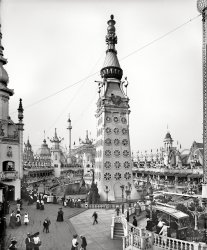
- Bookworm: 1921
- ... was the original Roxy in the 1926 Broadway premiere of "Chicago," so I guess she can darn well put her shoes on the cushions. I see ... Posted by Dave - 08/19/2012 - 5:18pm -
![Bookworm: 1921 New York circa 1921. "Larrimore." Francine Larrimore, French-born star of stage, screen and library. 5x7 glass negative, G.G. Bain Collection. View full size.
Shoes off the furniture, please!I must have heard that phrase hundreds of times, as a kid! I don't have to worry about it, now, because I just don't wear shoes unless I am leaving home. Maybe Mlle. Larrimore should try it!
NonchalanceThy name is Francine. "Just one more, please."
ShoesHer shoes were probably as much the style of the time as they could have been the ladies weapon of the day! Ouch!!
It's RoxyFrancine was the original Roxy in the 1926 Broadway premiere of "Chicago," so I guess she can darn well put her shoes on the cushions. I see women wearing pointy-toed shoes like this every day.
What do you callthat piece of furniture that she is reclining on ?? It's too deep/high/big/long/hard/shallow/uncovered to be anything that I'm familiar with.
[It's a daybed. - Dave]
Nice mittsLook at the size 'o those hands! "Excuse me Ms. Larrimore, when you're done with that passage would you mind opening this pickle jar for me?" She must have absolutely dominated international thumb wars back in the day.
(The Gallery, G.G. Bain, NYC)](https://www.shorpy.com/files/images/32555u.thumbnail.jpg)
- Clinton: 1943
- March 1943. "Freight operations on the Chicago & North Western between Chicago and Clinton, Iowa. The train going through Clinton to the yard two ... still exists today.
Two depots, three railroads The Chicago & Northwestern passenger depot is the large structure in the ... Posted by Dave - 10/26/2016 - 5:17pm -
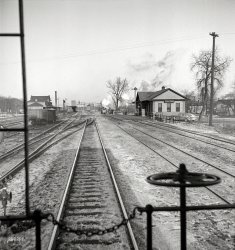
- Happy Meals: 1943
- ... 1943. "Restaurant sign on the bus route through Indiana to Chicago." Photo by Esther Bubley for the Office of War Information. View full ... Kentland many times on a weekly commute down US-41 from Chicago to Terre Haute.
The Nu Joy Restaurant appears to still be there ... Posted by Dave - 02/25/2014 - 7:39pm -
![Happy Meals: 1943 September 1943. "Restaurant sign on the bus route through Indiana to Chicago." Photo by Esther Bubley for the Office of War Information. View full size.
Kentland, IndianaA photo of the entire restaurant (entitled NU-JOY RESTAURANT, GREYHOUND BUS STOP, KENTLAND, INDIANA) courtesy of the Allen County Public Library. Kentland is in the northwest quadrant of Indiana, but not in Allen County. I believe that library (in Ft. Wayne) is known to have excellent historical reference department.
Kentland, IndianaNu-Joy Restaurant, Gas Station, & Greyhound Bus Station
Been thereI drove through Kentland many times on a weekly commute down US-41 from Chicago to Terre Haute.
The Nu Joy Restaurant appears to still be there http://www.bizapedia.com/in/THE-NU-JOY-RESTAURANT-INC.html
[That page is for the corporate entity, not the restaurant, which it lists as "dissolved." The Web is full of these clickbait pages of ancient business records for long-defunct companies. - Dave]
Been there, done that!I grew up not far from Kentland, and our family ate at the Nu-Joy a few times. Glad to see someplace I've been on Shorpy!
Got a last minute lunchI ate here back in 1993 on my way up to Chicago. Turns out it was sold the following year. As far as I know, it was not re-opened, and I think the building is gone now.
(The Gallery, Eateries & Bars, Esther Bubley)](https://www.shorpy.com/files/images/SHORPY_8d33231u.thumbnail.jpg)























